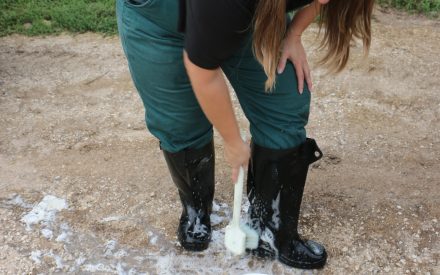✅ There are currently no cases of HPAI in dairy cattle in Wisconsin.

What is Highly Pathogenic Avian Influenza (HPAI) H5N1 virus?
Highly Pathogenic Avian Influenza (HPAI) H5N1 virus is an emerging issue that poses a significant threat to the health and well-being of dairy herds. HPAI, primarily known for its devastating impact on avian species, has recently been observed and identified in dairy cows. This influenza strain, characterized by its rapid transmission and morbidity among affected animals, requires coordinated action from all stakeholders.
Dairy farmers and the industry should prioritize strategies aimed at prevention, early detection, biosecurity, and effective management to mitigate the spread of this disease and minimize its adverse effects. Below are considerations and resources to help protect animals and humans from HPAI.
Current Situation in Wisconsin
✅ There are currently no cases of HPAI in dairy cattle in Wisconsin.
May 19, 2025 – Wisconsin to Begin Monthly Milk Sampling as Part of the National Milk Testing Strategy (Wisconsin DATCP) ↗️
Read more about detailed HPAI testing requirements from USDA APHIS ↗️.

Current Situation in the United States
States with Restrictions and Confirmed Cases of HPAI
Protecting animals from HPAI
While stopping the transmission of HPAI is complex, several ways exist to protect dairy farms from exposure.
- HPAI virus can be transmitted by waterfowl and other birds, infected cattle, and small mammals (skunks, raccoons, cats)
- Minimize access of wild birds to cattle and their environment
- Manage the movement of cattle and their transport as much as possible
- Do not feed unpasteurized colostrum or milk to calves, cattle, or other mammals
- Implement precautions for caretakers and veterinary teams handling sick cows, sick or dead birds, small mammals, and unpasteurized milk
- Separate (quarantine) all new or returning animals for at least 21 days
- Animal symptoms may include:
- Drop in feed intake
- Drop in rumination
- Decreased milk yield
- Changes in milk (thicker and yellow to brown)
- Widespread increase in milk conductivity
- Respiratory symptoms
- Fever
- Observations have reported a 4-6 day period of peak incidences in an affected herd that decreases at 10-12 days.
- On average, animals have been reported to recover within 30-45 days.
- Contact your herd veterinarian if increased cow illness is observed in your herd, specifically in 2nd lactation or greater cows that are 150 days or more in milk.

Other Resources
UW-Madison, Division of Extension
New Biosecurity Videos Teach Livestock Owners how to Mitigate Disease Spread
Wisconsin Veterinary Diagnostics Laboratory
HPAI in dairy cattle: WVDL update and links to biosecurity recommendations
National Milk Producers Federation
HPAI Resources, including state with travel restrictions and confirmed cases ↗️
National Milk Producers Federation and American Association of Bovine Practitioners
Dairy Biosecurity Recommendations – HPAI and More
Secure Milk Supply
Protecting humans from HPAI
The risk of humans getting HPAI is low, but infections have happened among highly exposed individuals. Humans exposed to infected animals should implement effective surveillance, preventative measures, and prompt treatment.
- Possible signs and symptoms of avian influenza infection in humans are:
- Fever
- Sore throat
- Runny or stuffy nose
- Eye irritation
- Body aches
- Fatigue
- Shortness of breath
- Headaches
- Use Personal Protective Equipment (PPE) ↗️ when entering new or contaminated facilities
- Clean boots or boot covers
- Clean clothing
- Encourage hand washing
- Self-monitor (check yourself for signs and symptoms of an illness and report your observations to the public health department)
- Perform daily temperature checks for fever
- Be alert for flu-like symptoms
- Provide daily updates about symptoms to the public health department ↗️
Additional information about HPAI can be found on the Wisconsin Department of Health Services website ↗️.
UW-Madison and Michigan State University have a helpful video series about reducing the spread of bacteria and PPE tips ↗️, offered in both English and Spanish.
According to the Food and Drug Administration, “there continues to be no concern that this circumstance poses a risk to consumer health, or that it affects the safety of the interstate commercial milk supply because products are pasteurized before entering the market.” Additional resources about milk and food safety are available on the FDA website ↗️.
Latest news about HPAI
Additional information about HPAI can be found on the Wisconsin Department of Health Services website ↗️.
Stay up to date with the most recent information as the situation progresses.
Sign up for updates from DATCP ↗️ and access more information on their website.
For more information, please visit the USDA APHIS Veterinary Services website ↗️.
Sign up for updates from DATCP on their website ↗️.
Now is an excellent time to review, update, or create a biosecurity plan for your farm. The FARM program offers a great biosecurity template ↗️ if you need to create one.
If you have questions regarding HPAI in animals, contact your Extension educator and/or veterinarian.
Authors

Aerica Bjurstrom
Regional Dairy Educator – Aerica’s work focuses on herd health and animal welfare. She also has a strong background in meat quality and has done programming in market cow carcass quality.

Jackie McCarville
Regional Dairy Educator – Jackie’s primary focus is dairy operations. She has experience in the private sector in animal nutrition and on dairy farms.
Updated: April 22, 2025
This article was originally published in 2024 with Faith Reyes contributing.
The University of Wisconsin–Madison Division of Extension provides equal opportunities in employment and programming in compliance with state and federal law.


 Step into biosecurity with clean and disinfected boots
Step into biosecurity with clean and disinfected boots Animal care starts with calf care
Animal care starts with calf care Heifer blueprint: Best practices for biosecurity
Heifer blueprint: Best practices for biosecurity ▶️ Watch:The importance of cow handling and a revolutionary way to practice
▶️ Watch:The importance of cow handling and a revolutionary way to practice


